| The move to Fryer Street The success in the T.T. produced a lot of publicity,
and an increase in orders followed. It soon became obvious that
the Heath Street premises were totally inadequate for the
manufacture of such a large number of machines. Larger premises
were essential and a new factory occupying 12,000 sq. ft. was
found in Fryer Street, next to the Chubb Building. The new works occupied the
piece of land between Long Street and Broad street, with the main entrance in Fryer Street, and the works entrance in Long
Street. The change of address was announced on 21st September in The
Express & Star newspaper, and the move was completed by the
middle of October. |
|
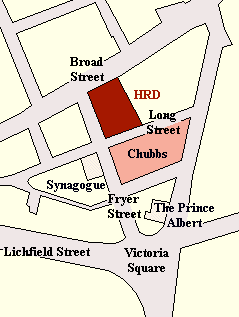
The location of the new factory. |
This was a busy time for the company. There were orders
to complete, the move to be organised, thought had to
be given to next year's models, and machines had to be got
ready for the show at Olympia. Although the new factory
covered a much larger area, it was
never fully equipped, and so its full potential wasn't realised, because
the company always suffered from a lack of money.
H.R.D. received some welcome publicity just before the
Olympia show. On 18th September,
Hubert Le Vack entered his HD90 at Brooklands and
gained a world speed record of 104.41m.p.h., for classes C & D,
and a British record for the flying mile.
The 1925 Olympia show opened on 21st September, over
a month earlier than usual. H.R.D. displayed five models, which were
much the same as those displayed at last year's show. |
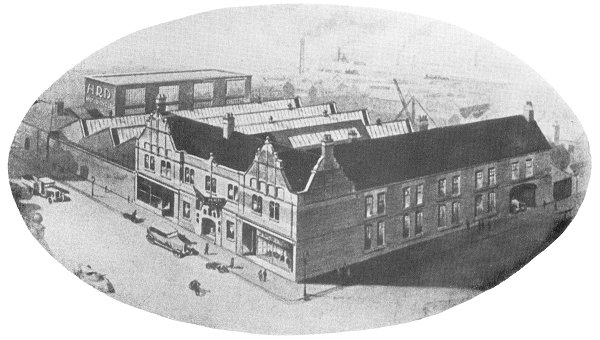
The Fryer Street premises. From the 1927
catalogue.
| The HD70 was
dropped, but the HD70/S remained, both in its original form, or
with a 600c.c. engine and a larger petrol tank.
The new 600c.c.
model cost an extra 5 guineas. The original 500c.c. solo model still
sold for 66 guineas and 83 guineas for the combination.
The
HD80 was unchanged and still sold for 80 guineas. The HD90 was
modified to make it as close as possible to the T.T. winning
machine. It had larger foot-operated brakes, with a ribbed
rear brake drum. The capacity of the petrol tank was increased from
2 gallons to 2 gallons 3 pints, an extra engine mount was fitted. The machine still sold for 90 guineas. |
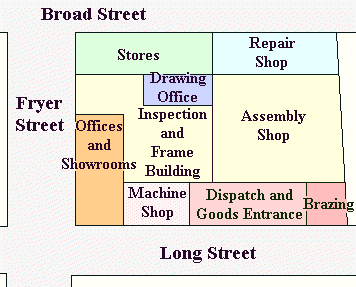
A plan of the new factory. |
|
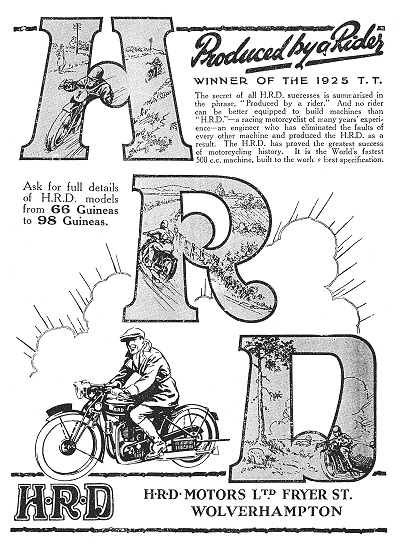
From Motor Cycling magazine, March 17th,
1926. |
The top of the range HD Super 90, was the same as the
HD90, but had a new 500c.c. twin port engine, and a top speed of around 100m.p.h. The machine
came with a Smith's
speedometer, Lucas electric lighting, and sold for 98 guineas. Sales continued much as before,
with 267 machines sold that year. Although sales were on the increase, the company was
still not profitable. A new duplex frame was developed, and H.R.D.
road tests were published in the February 1926 edition of 'Motor
Cycling' magazine and 'The Motor Cycle'. Both magazines were very
enthusiastic and the machines were highly rated.
Thoughts soon turned to the 1926 Isle of Man T.T. A servo braking system was
developed in readiness, which performed very well in trials, but in
the end it was decided that the tried and tested traditional
brakes, would continue to be used.
|
| In the left foreground is
Howard Birrell and behind him is Eddie Twemlow and Eddie Jones.
Behind them, to the left of machine
number 1 is Albert Clarke, and to the right of the machine is
Ken Twemlow.
Howard Davies is at the back, on the left
of machine 'C'. Next right is Theo Hupperdine. On the right
of the machine is Sidney Jackson. On the extreme right with his
back to the camera is Harry Harris. |
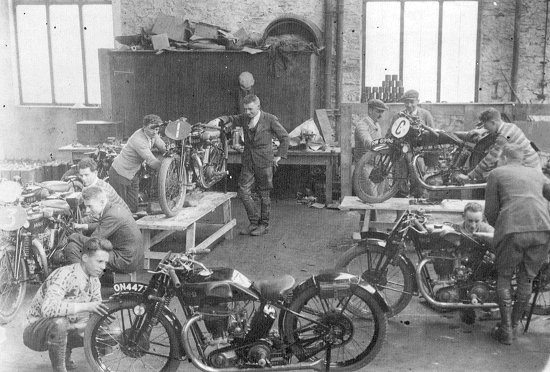
The H.R.D. T.T. workshop
in Atholl Street, Douglas. |
|
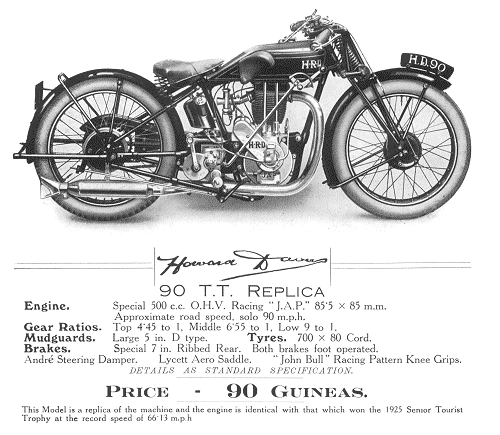
From the H.R.D. catalogue. |
There were three H.R.D. entries for the Junior, two from the
factory and one private, supported by the company. The company's entrants were Eddie Twenlow and Kenneth Twenlow.
T.R. Jones entered privately.
In the Senior there were five factory entries
and three supported private entries.
The company's entrants were Howard
Davies, Eddie Twenlow, Kenneth Twenlow, Harry Harris and Clarry Wood.
The
private entrants were Ossie Wade, his son John, and Sidney Jackson. |
| The practice sessions went very badly from the
start. It was obvious that the H.R.D.s could not match the speed of
many of the other entrants. The fastest time for an H.R.D. was 77.6m.p.h.,
whereas Frank Longman's A.J.S. achieved 84.9m.p.h., and many
others reached over 80m.p.h.
Moral was low and tempers frayed. Howard Davies sacked Theo Hupperdine on the spot. Theo, one of the mechanics, made
some derogatory remarks about the performance of the machines. |
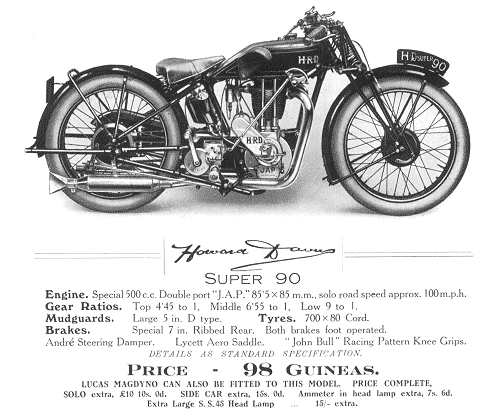
From the H.R.D. catalogue. |
|
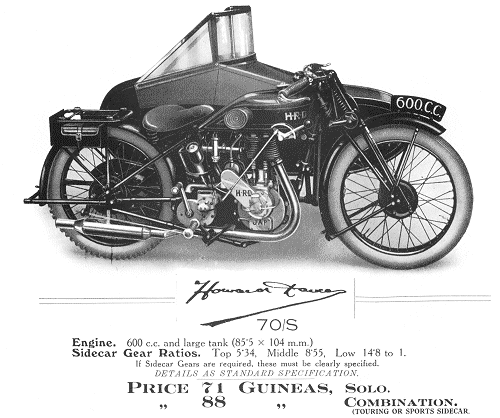
From the H.R.D. catalogue. |
Behind the scenes a lot of work was carried out to try and
improve the performance, but all to no avail.
In the Junior race, Eddie Twenlow fell during the first lap at Quarter Bridge and managed to continue.
Unfortunately he had to retire in the fourth lap with a dead engine.
T. R.
Jones also retired on the fourth lap with a broken engine. Kenneth Twenlow,
the only team member to finish, ended in 11th place. |
| In the Senior race, Howard Davies was in 3rd place
at the end of the 3rd lap. On the 4th lap he crashed at Gooseneck
and grazed his chin. He managed to continue, but the mishap had
dropped him down to 6th place. His engine soon failed and he had to
retire. Eddie Twenlow also finished in the 4th lap, with a dead
magneto. John Wade crashed at Bradden Bridge.
The race was won by
Stanley Woods on a Norton. Clarry Wood finished in 5th place, Sidney
Jackson finished in 8th place, Kenneth Twenlow finished in 9th
place, Harry Harris finished in 16th place and Ossie Wade finished
in 21st place. |
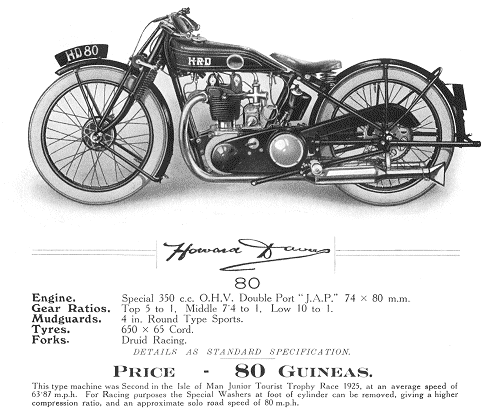
From the H.R.D. catalogue. |
|

From the H.R.D. catalogue. |
It was a disaster for Howard, who had hoped to
repeat his performance of 1925.On his return to Wolverhampton Howard
had to decide on next year's machines, and what would be on display
at Olympia.
The exhibition was due to open on 14th October and so there
wasn't much time to sort things out. The models that were
displayed consisted of a few of the old favourites and some
entirely new machines. |
| The HD90 was replaced by the HD75. Although the new
machine sold for 75 guineas, it retained most of the original HD90's
features and so was good value for money. It had a 500c.c. overhead
valve, JAP engine, with the original fixing. Webb forks were
supplied with adjustable shock dampers. The machine also included a
Pilgrim mechanical lubricator and was capable of 75m.p.h. The HD70/S
remained at its old price and a de luxe version was produced. The
new machine was the HD 600 De Luxe. It was powered by a 600c.c.
sports, side valve, JAP engine and sold for 72 guineas. |
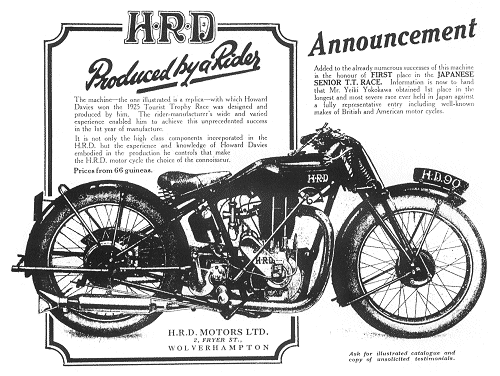
From the Motor Cycle Magazine, 27th May,
1926. |
|

The Fryer Street Works in the 1970s.
Courtesy of David Clare. |
The HD Super 90 remained at its old price, and was also available with
a 600c.c. engine for an extra 5 guineas. The HD80 remained at its old price,
and there were two
new 350c.c. models, the HD60, and the HD65.
The HD60 was aimed at the lower end of the market,
and had a sports 350c.c. side valve, JAP engine, Druid forks with shock dampers,
a top speed of around 60m.p.h., and sold for 60guineas.
The HD65 was more or less identical to the HD60,
but came with a standard 350c.c.
overhead valve, single port, JAP engine. It had a top speed of around
65m.p.h., and sold for 65 guineas.
There was also a de luxe touring sidecar which sold for 22
guineas. A total of 337 machines were sold in 1926, an increase of 70 on
last year's figures. But the company was still loosing money. For the 1927
range, H.R.D.'s sales policy remained unchanged. Relatively small numbers of
machines were produced and buyers were urged to order well in advance. |
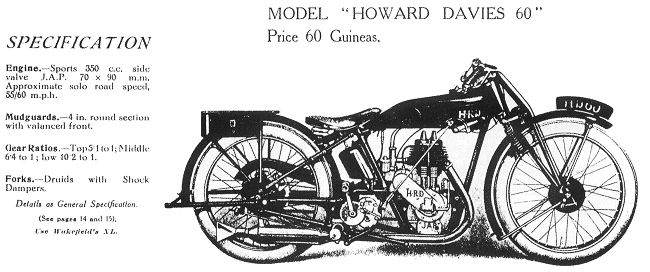
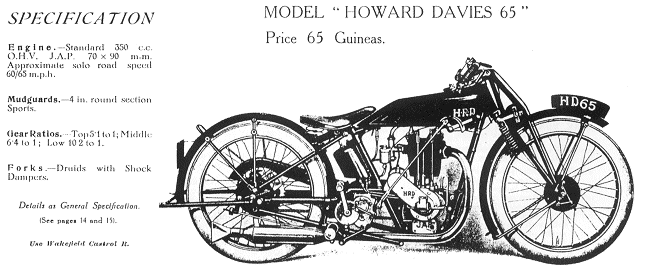
| There was always a waiting list, and the earlier
production problems were never resolved.
Throughout 1927, H.R.D.
machines continued to have a lot of success in competitions, and so
the company continued to get good publicity.
The competition
successes were featured in the company's adverts and also in the
adverts produced by some of the component suppliers. |
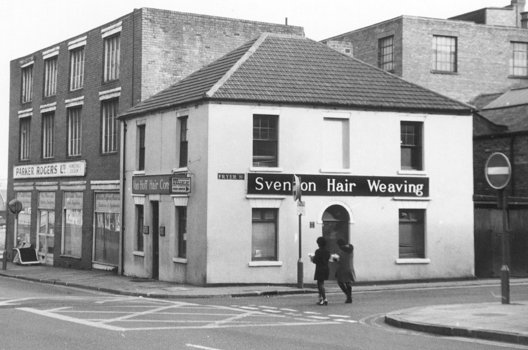
The Broad Street side of the works with the
repair shop on the left and the stores on the right. Courtesy of
David Clare. |
|
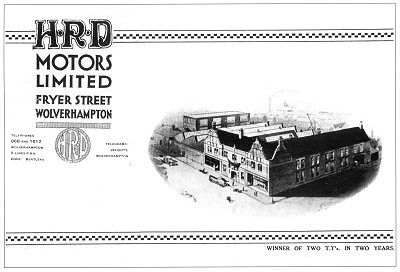
The 1927 catalogue. |
Around Easter, plans were made for the forthcoming T.T. It
was important that the H.R.D. machines should perform well, as this had a
direct effect on sales.
The general strike of 1926 and the trade recession
had effected sales. H.R.D. machines were always expensive and were aimed at
the top end of the market. This part of the market was badly hit by the
recession and so something had to be done. |
| There was some doubt as to whether Howard would
compete in the 1927 T.T., as he had put on a lot of weight and was
quite unfit. In the end he decided to only enter for the Senior. The
entries for the Junior were Freddie Dixon for the company, and R.V.
Crauford, privately.
The entries for the Senior were Howard Davies, Clarry Wood and Freddie Dixon.
The practice sessions went quite
well. The H.R.D. team were being tipped finish in the first three in
the Senior, even though their speeds were lower than those of the
Norton team. |
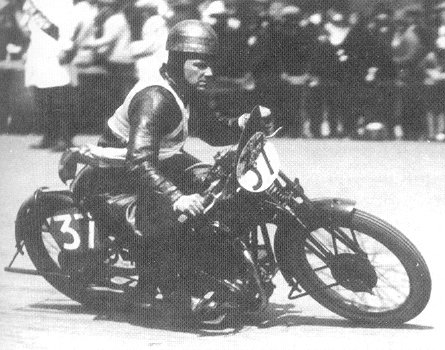
Freddie Dixon dashing through
Parliament Square in the 1927 Junior T.T. |
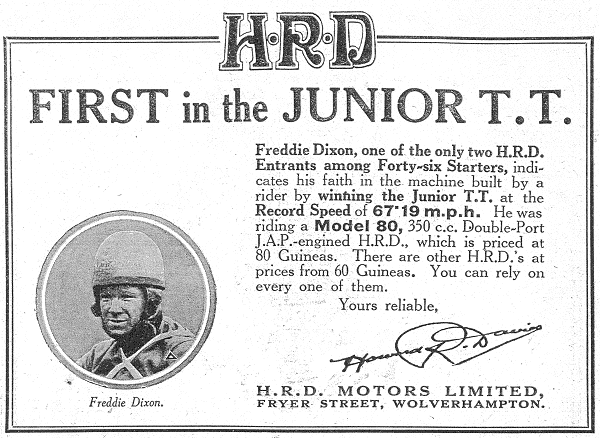
From 'Motor Cycling' magazine, 15th June, 1927.
| In the Junior, R. V. Crauford retired on lap five at
Bray Hill, with brake problems, but Freddie Dixon and his machine
performed flawlessly. Freddie went on to win the race at a record
speed of 67.19m.p.h. In the Senior there were problems on the first
lap. Clarrie Wood took a fall at Quarter Bridge, where the road was
in a greasy condition. Luckily he was unhurt and managed to
continue. Howard's machine was suffering from lubrication problems
and he had to retire on the next lap, at Sulby. Clarrie Wood had to
retire on lap 4 at Hillberry with a buckled rear wheel. This was a result of his fall in the first lap. Freddie Dixon's machine again performed extremely well and he
finished in 6th place. The winner was Alec Bennett on a Norton. |
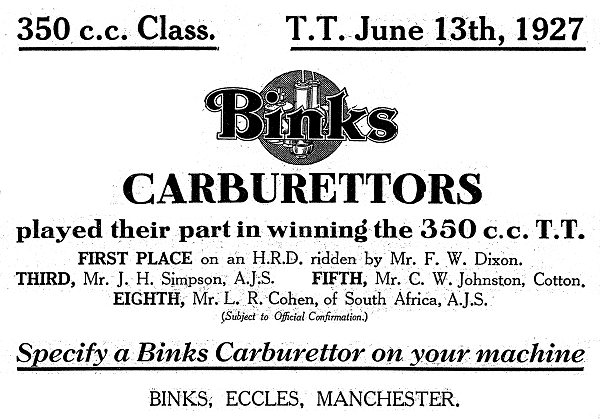
From 'Motor Cycling' magazine, 15th June, 1927.
| Back in Wolverhampton, the team was given a warm
reception and many celebrations followed, including a Civic
reception on 21st June for both H.R.D. and Sunbeam, whose team
gained the team prize in the Senior race. Three decorated lorries
carrying H.R.D., A.J.S. and Sunbeam machines arrived at Chapel Ash.
They were joined by the police band, the mounted police, and two
cars. The first car carried Howard Davies and the second carried
Freddy Dixon. A procession quickly formed, which was led by the police band
and the mounted police. A large crowd saw the procession depart for Victoria
Square, where the reception was held at the Victoria Hotel. A crowd of about
2,000 people gathered outside the hotel and Howard Davies, Freddie Dixon,
the Chief Constable and Alderman Myatt, climbed on to the narrow balcony to
receive the crowd's greeting. Another reception was given by Freddie Dixon's
club, the Middlesbrough and District M.C.C.
When the celebrations were over, a lot of hard work
was necessary to make the company profitable again. A sales drive
was organised and everyone did all that they could to promote sales.
Six machines were prepared for the Olympia show in October. The
model range remained the same as the previous year, and prices were
reduced to try and improve sales.
Sales however got worse, only 214
machines were sold that year and each machine lost money. The
company had never been profitable. The net loss was £440 in 1925,
£1,223 in 1926, and £6,600 in 1927. The company went into voluntary
liquidation in January 1928, and at the end of the month was
purchased by Ernest Humphries, of O.K. Supreme Motors. He decided to
sell the name, jigs, tools and patterns, and these were soon sold to
Philip C. Vincent, for £500. Vincent wanted to start manufacturing
motorcycles and needed an established name to get things off to a
good start. Production moved to Stevenage, and the new machines were
called Vincent H.R.D. The H.R.D. part of the name was soon dropped
and the machines were sold under the Vincent name.
Around 850 H.R.D. machines
were built in Wolverhampton. Only about 18 complete
machines, and a number of incomplete machines are known to exist,
although others may well be found in the future. |
Geoff Preece's book "H.R.D.
Motor Cycles. Produced by a Rider". Published by J. Bickerstaff, has
been an invaluable reference in producing this story.
|



